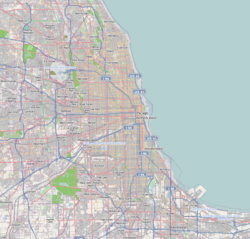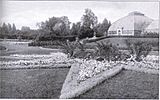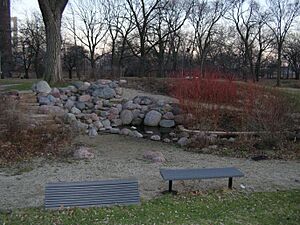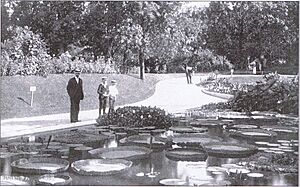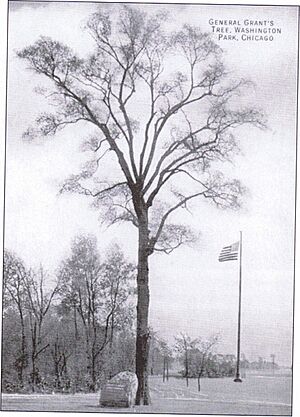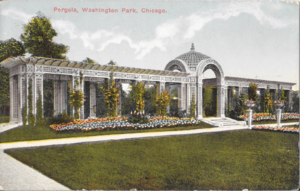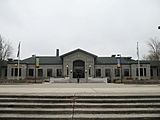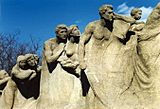Washington Park (Chicago park) facts for kids
Quick facts for kids |
|
|
Washington Park
|
|
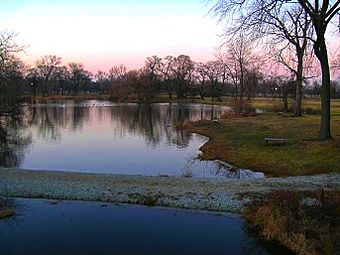
Pond in Washington Park
|
|
| Location | 5531 S. King Dr., Chicago, Illinois |
|---|---|
| Area | 380 acres (1.5 km2) |
| Built | 1870 |
| Architect | Olmsted, Frederick Law; Burnham, Daniel H. |
| Architectural style | Beaux Arts, Art Deco |
| MPS | Chicago Park District MPS |
| NRHP reference No. | 04000871 |
| Added to NRHP | August 20, 2004 |
Washington Park is a large park in Chicago, Illinois. It covers about 372 acres (1.5 km²) and is located on the city's South Side. The park was named in 1880 after President George Washington. It is one of several parks in Chicago named after people with the last name Washington.
Inside Washington Park, you'll find the DuSable Museum of African American History. The park was also considered as a possible location for the Olympic Stadium if Chicago had hosted the 2016 Summer Olympics. Washington Park became a historic place on August 20, 2004.
Contents
How Washington Park Was Planned
The idea for Washington Park came from Paul Cornell, a Chicago businessman. He helped create the South Park Commission in 1869. This group looked for a large area south of Chicago to build a big park and connecting roads.
The land was first called South Park and was split into two parts: an eastern part (now Jackson Park) and a western part (now Washington Park). In the 1870s, famous landscape designers Frederick Law Olmsted and his partner, Calvert Vaux, were hired to design the park. Sadly, their original plans were lost in the Great Chicago Fire of 1871.
When Olmsted first saw the land, it was mostly open fields. He decided to keep it natural by creating a large grassy area surrounded by trees. His plan even included having sheep graze in the park to keep the grass short! The western part of South Park was officially renamed Washington Park in 1881.
Olmsted also designed the park to be part of Chicago's wider boulevard system. This meant you could travel from Washington Park to other parks and areas using grand roads. For example, the Midway Plaisance connects Washington Park to Jackson Park.
Building the Park
Building Washington Park faced challenges because of the Great Chicago Fire in 1871 and a financial downturn in 1873. Even with these problems, much of Olmsted's original vision for the park came true.
From 1897 to the 1930s, the park had a beautiful conservatory (a large greenhouse) and a fancy sunken garden. However, during the Great Depression, many conservatories in Chicago, including Washington Park's, were taken down due to lack of money. Today, only the Lincoln Park Conservatory and Garfield Park Conservatory remain as Chicago's main conservatories.
One of the first improvements was the "South Open Green," a large grassy area where sheep grazed and people played ball. Famous architect Daniel Burnham's company designed several buildings for the park, including the stables (1880), the refectory (a dining hall, 1881), and the administrative building (1910).
Early attractions in the park included:
- Riding stables
- Cricket grounds
- Baseball fields
- A toboggan slide
- Archery ranges
- A golf course
- A swimming pool
- Bicycle paths
- Row boats
- Horseshoe pits
- Greenhouses
- A rose garden
- A bandstand
- A small zoo with six alligators
- A lily pond
The lily pond was very popular because it was a rare sight for many people. Today, the old administrative building is home to the DuSable Museum of African American History. The park continues to be a beautiful green space, following the ideas of the Burnham Plan which aimed to keep Chicago's park system strong.
Park Activities and History
On December 6, 1879, former U.S. President Ulysses S. Grant visited the park and took part in a tree planting ceremony. A special rock and plaque marked the spot, but they have since been removed. In the 1920s, semi-professional baseball teams, often made up of African American players, played games at Washington Park.
From 1883 to 1905, the Washington Park Race Track operated at the southeast corner of the park. It was one of the biggest horse racetracks of its time. A nine-hole golf course was even built inside the track! Some of its buildings, like the stables used by the Chicago Police, are still there today. The racetrack closed when gambling became illegal in Illinois.
Washington Park has also hosted the USA Cross Country Championships many times, in years like 1933, 1957, and 1972.
After World War I, many African Americans moved into the neighborhood around Washington Park. The park became an important place for the community. Since 1961, it has been home to the DuSable Museum of African American History, which celebrates African American history, art, and culture.
The 2016 Olympic Bid
In 2006, Chicago's Mayor Richard M. Daley announced a plan to build an Olympic Stadium in Washington Park. This was part of Chicago's attempt to host the 2016 Summer Olympics. The stadium would have held 95,000 people for the games. Afterward, it would have been changed into a smaller 10,000-seat arena for sports and cultural events.
The plan also included new hockey fields and a way to connect the two halves of the park by putting part of Morgan Drive underground. Later, in 2008, a plan to add the Olympic swimming venue to the park was also considered. However, some people were against the plan because Washington Park is a historic landmark. They worried that building a stadium there would harm its historic status. In October 2009, Rio de Janeiro was chosen to host the 2016 Olympics, so these plans for Washington Park were stopped.
Washington Park Today
Washington Park is recognized as a United States Registered Historic District. This means it's an important historical area. Key sights in the park include the DuSable Museum of African American History and its outdoor sculpture garden. You can also see the famous Lorado Taft sculpture called Fountain of Time and a unique National Guard armory building.
Washington Park is a busy social hub for Chicago's South Side. It hosts many summer festivals, including Chicago's well-organized cricket league. It's also the end point for the big Bud Billiken Parade and Picnic. Every fall, the UniverSoul Circus comes to the park. The park is also home to Chicago's largest 16-inch softball league, with many teams playing on its fields every Sunday.


